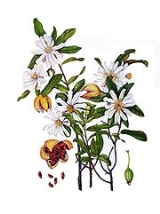
Xylotheca kraussiana
Encyclopedia
Xylotheca kraussiana is an African shrub or small multi-stemmed tree growing in the sandveld and widely distributed throughout the eastern parts of Southern Africa, in particular the eastern Transvaal
, coastal Natal and Mozambique
, preferring the sandy soils of coastal bush and forest.
'Xylotheca' meaning 'woody case' and the species name honouring Dr C.F.F. Krauss (1812-1890), a German naturalist, who later became director of Stuttgart
's Natural History Museum. Krauss came to the Cape in 1838, collected in Natal from 1839 to 1840. About 8 other species of Xylotheca are to be found in central Africa and Madagascar
.
Leaves are dull grey-green, alternate and covered in soft grey hairs. Flowers are white with a dense central cluster of yellow anthers and resembling a small white rose. The fruit is an ovoid woody capsule about 40mm long and distinctly ridged. Yellow when ripe, it partly splits into 5 sections revealing black seeds with a bright red aril. The pulp around the seeds is relished by birds.
This plant used to belong to the family Flacourtiaceae
, but was relocated to Achariaceae
by the Angiosperm Phylogeny Group
.
Transvaal Province
Transvaal Province was a province of the Union of South Africa from 1910 to 1961, and of its successor, the Republic of South Africa, from 1961 until the end of apartheid in 1994 when a new constitution subdivided it.-History:...
, coastal Natal and Mozambique
Mozambique
Mozambique, officially the Republic of Mozambique , is a country in southeastern Africa bordered by the Indian Ocean to the east, Tanzania to the north, Malawi and Zambia to the northwest, Zimbabwe to the west and Swaziland and South Africa to the southwest...
, preferring the sandy soils of coastal bush and forest.
'Xylotheca' meaning 'woody case' and the species name honouring Dr C.F.F. Krauss (1812-1890), a German naturalist, who later became director of Stuttgart
Stuttgart
Stuttgart is the capital of the state of Baden-Württemberg in southern Germany. The sixth-largest city in Germany, Stuttgart has a population of 600,038 while the metropolitan area has a population of 5.3 million ....
's Natural History Museum. Krauss came to the Cape in 1838, collected in Natal from 1839 to 1840. About 8 other species of Xylotheca are to be found in central Africa and Madagascar
Madagascar
The Republic of Madagascar is an island country located in the Indian Ocean off the southeastern coast of Africa...
.
Leaves are dull grey-green, alternate and covered in soft grey hairs. Flowers are white with a dense central cluster of yellow anthers and resembling a small white rose. The fruit is an ovoid woody capsule about 40mm long and distinctly ridged. Yellow when ripe, it partly splits into 5 sections revealing black seeds with a bright red aril. The pulp around the seeds is relished by birds.
This plant used to belong to the family Flacourtiaceae
Flacourtiaceae
Flacourtiaceae is a defunct family of flowering plants whose former members have been scattered to various other families, mostly to Achariaceae, Samydaceae, and Salicaceae. It was so vaguely defined that hardly anything seemed out of place there and it became a dumping ground for odd and anomalous...
, but was relocated to Achariaceae
Achariaceae
Achariaceae is a family of flowering plants, formerly consisting of 6 species in 3 genera of herb and shrubs endemic to southern Africa. More recently, the APG II system has greatly expanded the scope of the family by including many genera previously classified in the Flacourtiaceae. Molecular...
by the Angiosperm Phylogeny Group
Angiosperm Phylogeny Group
The Angiosperm Phylogeny Group, or APG, refers to an informal international group of systematic botanists who came together to try to establish a consensus on the taxonomy of flowering plants that would reflect new knowledge about plant relationships discovered through phylogenetic studies., three...
.

